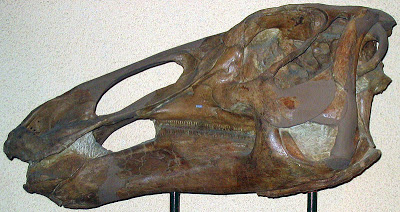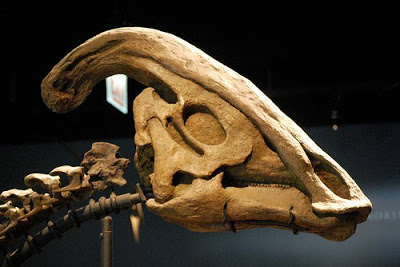

| Visitors Now: | |
| Total Visits: | |
| Total Stories: |

| Story Views | |
| Now: | |
| Last Hour: | |
| Last 24 Hours: | |
| Total: | |
SVP 2012 – The Ornithischians
Friday, November 9, 2012 22:22
% of readers think this story is Fact. Add your two cents.
Victoria Arbour and ankylosaurs go together like two peas in a pod and I’m pleased to say that her love affair with these unusual armoured behemoths continues. This year Victoria, from the University of Alberta, and co-author Phil Currie presented their latest research into the taxanomic affinities of ankylosaurids from the Gobi Desert of Mongolia.
A recently discovered ankylosaurid skull from Upper Cretaceous sediments of the Baruungoyot Formation at Khermeen Tsav displays a number of new cranial characters and two distinct features, one of the squamosal horns and one of ornamentation located posterior to the orbit, that indicate this may be a new taxon since these features are not known in either Saichania or Tarchia.
Although the authors have not formally identified the new skull, they recognised the importance of the specimen and have run a phylogenetic analysis using the updated codings taken from the new skull. They also included a re-evaluated data set from two specimens of Saichania as the only currently known ankylosaurid from Baruungoyot including the holotype (MPC 100/151).
The analysis reveals that Minotaurosaurus, Pinacosaurus grangeri and the new skull are a closely related group whilst Pinacosaurus mephistocephalus and Saichania are also recovered as being closely related but are further removed from the new specimen than the other taxa. Although this latest analysis brings our phylogenetic understanding of Mongolian ankylosaurids to a new height of understanding there are still many question marks and the authors quantify this by stating that the amount of postcranial remains found in association with skulls is scarce and that this data should be viewed with this in mind.
A couple of weeks prior to SVP taking place, Greg Erickson et al presented their findings regarding dental structure and wear biomechanics in hadrosaurids in Science magazine and the same team also presented their research at the meeting.
Hadrosaurids were unique dinosaurs – especially when it comes to the makeup of their teeth. Using three dimensional tribological modelling has revealed some intricate yet amazing detail. Simple reptilian teeth are made up of two dental tissues, mammals have four but hadrosaurid teeth are comprised of six distinct dental tissues. The complexity of this structure is astonishing, especially when you see that this dental tissue arrangement varied both within and across the teeth, in effect allowing a single tooth to perform different functions in different places such as grinding or chewing.
This unique set of dental characters in combination with the already celebrated hadrosaurid jaw mechanics likely gave the group a significant advantage over other contemporary herbivorous dinosaurs. In effect, these dinosaurs were able to eat almost anything and were able to adapt to other food sources when others became scarce and this almost certainly enabled them to dominate the Late Cretaceous environments right up to their terminal demise at the end of the Maastrichtian.
Parasaurolophus is another of those wonderful iconic dinosaurs with its large tube-like crest that contains part of the nasal passages sweeping back over the skull. Despite being represented by numerous remains the cranial ontogeny of Parasaurolophus is unclear – especially when compared with other lambeosaurines.
But now Andy Farke et alhave been looking at an exceptionally well preserved juvenile specimen recovered from the Upper Cretaceous Kaiparowits Formation of southern Utah. The authors presented this data as a poster at SVP and the images they used were life sized! I cannot stress how beautiful this specimen is – a real jewel and extremely important.
The skull is 240mm long and the overall length of the specimen is between 1.9 and 2.5 metres. Data of note includes an extension of the upper beak that extended approximately 30mm beyond the premaxilla which enabled faster harvesting and a larger cropping area due to the expansion. The crest is semi-circular in lateral profile as opposed to the usual tubular configuration found in adults. The crest is also at a more progressive stage than you would expect to find in other taxa at a similar ontogenetic stage.
The authors interpret this as an almost expected ontogentic trait in Parasaurolophus since the crest is extremely large in adults and therefore it would seem likely that it would need to be growing at a faster rate at an earlier age to reach the adult iteration. The crest also demonstrates advanced nasal development at this stage when compared to other lambeosaurines. The specimen suggests that the increased nasal complexity of hadrosaurid and lambeosaurid crests dictated the early development of the structures in juveniles.
One poster that has certainly seen a lot of publicity since the meeting is that of Joseph Peterson and Collin Dischler, both of the University of Wisconsin, which looked at the frontoparietel domes of pachycephalosaurids. Pachycephalosaurs have often been depicted as head butters but this has been challenged throughout the last decade (eg Goodwin & Horner 2004) since it appeared that the domes are composed of porous bone that is associated with vascular tissue and that it is not congeneric with a butting scenario. And since the domes changed throughout ontogeny it seems reasonable to suggest that the heavy ornamentation was useful for intraspecific communication and recognition.
However, further studies of pathologies and structural models have again lent support to the head butting hypothesis. This latest study involves domes from multiple pachycephalosaurid taxa and looks at lesions, remodelling and pathologies and their distribution on the domes and, by using specific homologous landmarks on the domes, were able to identify some interesting patterns.
All taxa bar one (Gravitholus) demonstrate a greater percentage of lesions on the dorsal surface of the frontal region. This is consistent despite the varying height, shape and size of the domes in the various taxa. The authors interpret this as evidence for both head butting and flank shoving since the locations of the lesions are consistent with just such behaviour. Perhaps the truth lies somewhere between the different hypotheses. Certainly I would not expect pachycephalosaurs to head butt like extant bighorn sheep would do. More sampling required for sure but at least the domes do appear to survive pretty well.
Along these same lines, and equally interesting, Collin Vanburen, of the University of Toronto, and colleagues have been looking at cervical fusion in ankylosaurs. Fusion occurs within the first two cervical vertebrae in three taxa – two nodosaurids and one ankylosaurid. Other taxa do not display this fusion but this may be a sampling issue since anterior cervicals are rarely found.
The morphological arrangement of this syncervical is akin to those of ceratopsians which was thought to be an adaption to cope with the evolution of their massive heads. Despite this similarity no appropriate theory has been formalised to account for the syncervical in ankylosaurs – until now. The heads of ankylosaurs, in comparison with ceratopsians, are actually quite small and this negates the large head support hypothesis.
Instead the authors suggest that this fusion of the anterior cervicals may have been a direct response to ecological pressures or behavioural patterns. This adaption may have been related to a specific feeding response, which kind of makes sense to me as only the three taxa (so far) display the syncervical, or, perhaps, that this may have been related to intraspecific head-to-head behaviour. The authors state that more extant comparisons need to be made with mammalian taxa and birds (eg hornbills) that demonstrate cervical fusion and, of course, so much more material needs to be found for a true comparison to be made. It would be interesting to see a study on ankylosaur skulls similar to the one being performed on pachycephalosaurs by Peterson and Dischler mentioned above.
Maiasaura peeblesorumis one of the best represented and best researched non avian dinosaurs in the world. And now Holly Woodward, of the Museum of the Rockies, and her colleagues have performed a wide ranging histological analysis of forty eight tibiae looking at ontogenetic and individual variation within the taxa.
As we have seen many times with other dinosaurs using histological research, Maiasaura grew very fast until attaining skeletal maturity. Lines of arrested growth (LAGS) show what has been referred to as demonstrating seasonal trends very similar to what has been described for hadrosaurs inside the Arctic Circle (see Chinsamy et al 2012). This apparent similarity in bone structure in animals from the south and the north suggests that this particular “evidence” does not necessarily support the theory that hadrosaurs were endemic residents in the north.
Maiasaura attained half adult size within the first year! They reached adult size around the nine to ten year old mark. Ontogenetic traits and comparisons made between Maiasauraand crocodiles clearly demonstrate that these dinosaurs grew at elevated rates and, because both groups display LAGS, then LAGS should not be used as indicators of slow growth rates and ectothermy.
Body size growth curves vary throughout ontogeny demonstrating variation within individuals and is suggestive of external influences on growth. The amount of tibiae recovered show a marked pattern in the size and age of the individuals and demonstrates that mortality in Maiasaura was high in the first year and, maybe surprisingly, also high in animals reaching skeletal maturity.
In fact over half of the sample examined represents animals of a year old or younger and just shows how important a large data set is and the authors state that forty eight tibiae are probably nowhere near enough anyway. But this is important research since there are very few dinosaurs represented in the quantities that Maiasauraare and gives us essential insights into the ontogenetic history of non-avian dinosaurs.
References
Arbour, V.M., Badamgarav, D. & Currie, P.J. 2012 A new ankylosaurid from the Upper Cretaceous Baruungoyot Formation of Mongolia: new cranial characters for ankylosaurine ankylosaurids and a reassessment of ankylosaurid postcranial specimens from Mongolia. Journal of Vertebrate Paleontology, SVP Program and Abstracts Book, 2012, pp 57.
Chinsamy, A., Thomas, D. B., Tumarkin-Deratzian, A. R. and Fiorillo, A. R. (2012) Hadrosaurs Were Perennial Polar Residents. The Anatomical Record: Advances in Integrative Anatomy and Evolutionary Biology (advance online publication) doi: 10.1002/ar.22428
Erickson, G.M., Krick, B., Norell, M.A. & Sawyer, W.G. 2012 Complex dental structure and wear biomechanics in hadrosaurid dinosaurs. Journal of Vertebrate Paleontology, SVP Program and Abstracts Book, 2012, pp 90-91.
Farke, A.A., Chok, D., Herrero, A. & Scolieri, B. 2012 Ontogeny in the hadrosaurid dinosaur Parasaurolophusrevealed by an articulated skeleton from the Kaiparowits Formation of southern Utah. Journal of Vertebrate Paleontology, SVP Program and Abstracts Book, 2012, pp 92.
Goodwin, M.B. and Horner, J.R. 2004 Cranial histology of pachycephalosaurs (Ornithischia: Marginocephalia) reveals transitory structures inconsistent with head-butting behaviour. Paleobiology, Spring, 2004, v. 30, p. 253-267.
Petersen, J.E. & Dischler, C. 2012 Distribution of injuries in pachycephalosaurids using frontoparietel landmarks. Journal of Vertebrate Paleontology, SVP Program and Abstracts Book, 2012, pp 157.
Vanburen, C.S., Arbour, V.M. & Evans, D.C. 2012 Cervical fusion in Ankylosauria: anatomy and function. Journal of Vertebrate Paleontology, SVP Program and Abstracts Book, 2012, pp 187-188.
Woodward, H.N., Horne, J.R. & Farlow, J.O. 2012 Paleobiological implications of growth history and histovariability in a population of the hadrosaurid dinosaur Maiasaura peeblesorum. Journal of Vertebrate Paleontology, SVP Program and Abstracts Book, 2012, pp 196.
2012-11-09 20:41:56
Source: http://saurian.blogspot.com/2012/11/svp-2012-ornithischians.html
Source:





